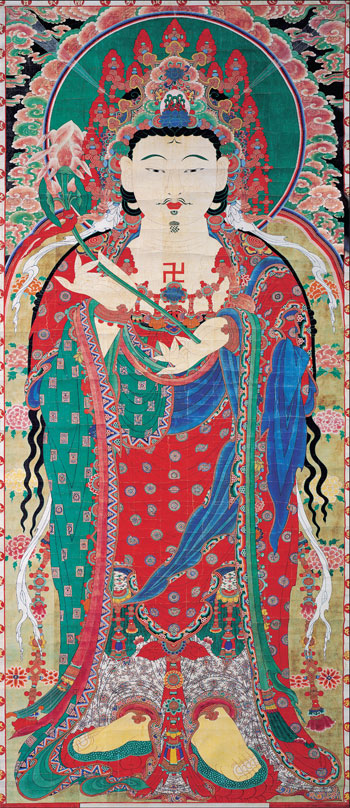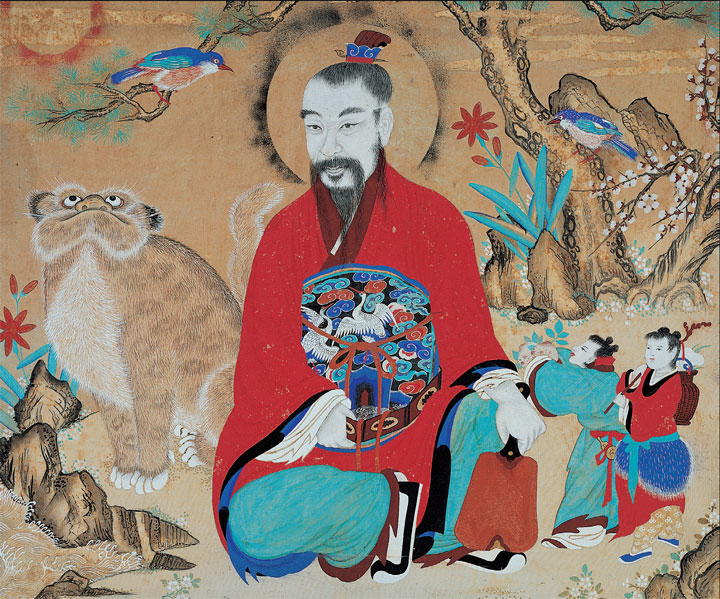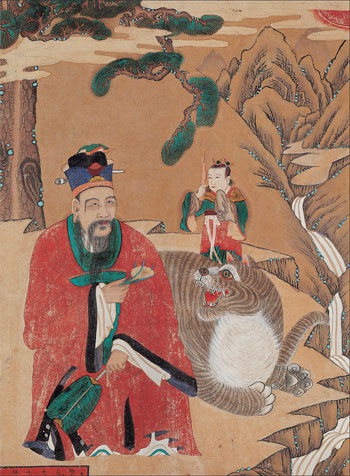 |
Foreigner's View |
 |
 |
 |
 |
 |
 |
Time To Show the World
One of the world' s best-kept secrets in art is Korean
gwaebul (huge outdoor ceremonial Buddha
scrolls), with Korean temple paintings not far behind. But world attention has swung from Japanese Zen art to Himalayan Buddhist art following
the growing popularity of Tibetan Buddhism.
In New York, the 61-year-old Jacques Marchais Museum of Tibetan Art and the grand Rubin Tibetan Art Museum, dedicated in 1999, stand as proud homes to Himalayan traditions.
Korea' s Tongdosa Museum, also dedicated in 1999, was founded for the preservation and display
of Korean Buddhist temple paintings. It is more than a museum, however: Upon entering, visitors remove shoes as if entering a temple and are invited to pay homage to the huge hanging gwaebul. These are on loan from temples and rotated every six months. It' s a stunning start to a museum tour. The National Museum in Seoul has adopted this six-month gwaebul rotation system as well.
However, being somewhat out-of-the way, Tongdosa
Museum has yet to draw an international following. Hopefully the 40-volume series Buddhist
Paintings of Korea by the Buddhist Cultural
Properties Research Institute, affiliated with the museum, will attract the attention that Korean temple art, including gwaebul, deserves. Also, let' s hope that philanthropists, private foundations, the government, and temples can now do more to introduce Korean gwaebul and temple paintings to the world.
These traditions are a proud heritage for all Koreans,
whether religiously affiliated or not. May I put it another way: Korean Buddhist art is not just Buddhist art, it is Korean art, and I feel it should be integrated as such. Is, for example, "HyoJeChungSin" (Filial Piety, Loyalty, and Fidelity)
called "Confucian calligraphy" ? Certainly
not. To see the astonishing number of Korean National Treasures and Treasures that are Buddhist
is to behold Korean history and culture, and to separate Buddhist art from Korean art or to ignore it almost totally seems grossly unfair, regardless of the trends of the times. There is never a mention of gwaebul and barely a mention of temple art in official English language materials on Joseon Dynasty art.
|
 |

1. Tongdosa Temple Gwaebuldo,
1204cm (H) x 493cm (W)
,1767
|

2. Pussycat Tiger, Buddhist Paintings of Korea, Vol. 16 (Magoksa Temple), p. 151 (Chungakdang Pavilion, Shinwonsa,
20th C.)
|
The institute has surveyed 71 Joseon Dynasty (1392-1910 C.E.) gwaebul. There are others from that period as well. Seven are National Treasures and 35 are Treasures, including the earliest known, from Juknimsa Temple in Naju, dating to 1622. The tallest is Ssanggyesa Temple' s at 13 meters high. To see gwaebul is incredible. To see one being raised at a ceremony
is like seeing the Buddha appear out of the earth, and it leaves you speechless.
The Himalayas also have a giant Buddha scroll tradition, although much art was destroyed, as during the Korean War here, during the Cultural
Revolution. This tradition includes applique first and then painting. The giant tangka of Amitabha
in Potala Palace in Lhasa is reportedly 55.8 meters high and 40 meters wide. Another, done in 1994 for the Tsurphu Monastery, is 23 meters wide and 35 meters high. Due to their huge sizes, these giant tangka are unfurled for a "sunning" (Buddha brightens the world) on a hillside on special occasions.
|
 |
Bhutan' s giant tangka tradition is at least 300 years old and no doubt linked to Tibet' s, as is Mongolia' s, where an 18-meter-high tangka of the God Orchirvaani is now being made. In Ladakh, a 4-story giant Tibetan-style tangka is hung every Year of the Monkey at the Hemis Festival. But the world knows too little about these great art traditions, as well.
The consensus now seems to be that Korea developed
its own gwaebul tradition following tragic foreign invasions of the late 16th and early 17th centuries that devastated the nation, in order to meet the needs of mass spirit-guiding
ceremonies. Word of Himalayan applique tangka could easily have reached Korea, but my own hunch is that the idea sprang from Korea' s large boulder relief buddhas, maaebul -many of which were evidently painted as virtual
outdoor temple paintings-from previous Korean kingdoms and dynasties. Regardless, it' s time to show the world.
|
Purrs and Roars and Snooping
Another fascinating art tradition in Korea is that of the Mountain God painting. These paintings,
too, are a product of the Joseon Dynasty, although much later (the oldest I could find is dated 1831) than gwaebul. The Mountain God is accompanied by a tiger, and to survey Mountain
God paintings is to have a grand time enjoying,
in the folk art tradition, these overgrown, thoroughly charming pussycats with their poses,
outlandish eyebrows, and big bright eyes. Prof. David A. Mason' s Spirit of the Mountains provides the international audience with a solid selection of photos of Mountain God paintings from around the nation. Hanguk Horangi (The Korean Tiger) has some fine photos, too, but unfortunately neither book provides dates.
Occasionally we can find a very serious tiger or an angry one. I began to wonder why, when most tigers were playful pussycats. So I resorted
to one of my favorite pastimes, snooping. One long winter night when my curiosity was up, I snooped through the 40 volumes of Buddhist
Paintings of Korea. Snoop, snoop.
In these impressive collections I found a total of 135 Mountain God paintings. Of them, 101 featured lovable pussycat tigers, outlandish eyebrows and all. Another seven were kind of roaring but in the hilarious folk art tradition. Twenty-five were either serious or angry tigers. One painting at Haeinsa Temple featured both a roaring and a pussycat tiger. One had no tiger. The next step was to find out what, if anything, the angry tigers had in common. Same part of the country? Similar painting traditions? Similar
line drawings?
More snooping. And then, voila! There it was! Maybe.
Forty-five of the 101 funny tiger paintings were done in the 20th century; but all of the 25 very serious and angry tigers were done after 1910, following the Japanese Occupation! Were they just a new style, or, as I now suspect, were they an indirect expression of the Mountain God' s (and Korea' s) anger at foreign control?
|

|
This theory demands more careful research, but on the basis of the 135 paintings, we may have an important point here.
And there' s another issue to be resolved. Why are a handful of the angry tigers roaring at the invariably innocuous Mountain God, a symbol of National Founder Dangun? That leaves me, and anyone else interested
in the subject, with just one alternative: more snooping!

3. Angry Tiger, Buddhist Paintings of Korea, Vol.16 (MagoksaTemple),p.154 (Muryangsa, 1920)
|
|
 |


